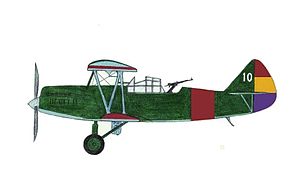Polikarpov R-Z
| R-Z | |
|---|---|
 |
|
| Polikarpov R-Z "Natacha" of the Spanish Republican Air Force | |
| Role | Reconnaissance/Light Bomber |
| Manufacturer | Polikarpov |
| First flight | 1935 |
| Introduction | 1935 |
| Primary user | Soviet Air Force |
| Number built | 1,031 |
| Developed from | Polikarpov R-5 |
The Polikarpov R-Z was a Soviet reconnaissance bomber aircraft of the 1930s. It was a revised version of the Polikarpov R-5 which was built in large numbers between 1935 and 1937. It was used in combat during the Spanish Civil War as well as the Winter War and Battle of Khalkhin Gol.
The R-Z or R-Zet was developed at the aircraft factory GAZ No 1 (State Aircraft Factory No 1) at Moscow as a development of, and a replacement for the Polikarpov R-5, the standard light reconnaissance bomber of the Soviet Air Force. Based on the R-5SSS, the most advanced variant of the R-5, the R-Z had a new, deeper, monocoque fuselage, with a sliding canopy for the pilot and fixed glazed fairing for the observer. The 544 kW (730 hp) M-17F engine (a licensed built copy of the BMW VI was replaced with the 611 kW (820 hp) M-34 engine. The R-Z first flew in January 1935 and was accepted for the Soviet Air Force in preference to the competing Kochyerigin LR, also an R-5 derivative. By the time production finished in spring 1937, 1,031 R-Zs had been built.
Like its predecessor the R-5, the R-Z was used in large numbers by both the Soviet Air Force and Aeroflot.
Its first use in combat was during the Spanish Civil War from 1937. 61 R-Zs were delivered to the Spanish Republican Air Force, where they were nicknamed Natacha. These were heavily used, flying in tight formations and using co-ordinated defensive fire to defend against fighter attack, while returning individually at low levels. Although many R-Zs were damaged by ground fire, and the 2ª Escuadrilla, Grupo 30 lost 9 of their 60 aircraft in one day on 24 December 1938, complete losses were relatively low with 36 surviving to be captured by the Nationalists at the end of the war in April 1939.
...
Wikipedia
